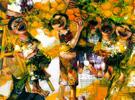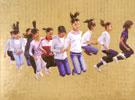I am not sure what is a 'typical’ Chinese any more than I know what is a 'typical' world? Potatoes are called potatoes when they have been dug from the earth. If they are grown in Yunnan, they are potatoes from Yunnan; similarly, potatoes grown in the United States are US potatoes. Interestingly, potatoes from different areas have been processed to make French fries or spicy chips.
Luo Xu
Contemporary art from non-Western art centers, i.e. Asia and Africa, are often dogged by the question of authenticity. Is this work genuinely local or diluted by an ersatz international vocabulary? Is it trading in the exotic or reaching out to international audiences? The dilemma is a trap from which artists find it hard to extricate themselves. Take contemporary Chinese artists as a case in point. In the early 1990s, many Chinese artists emerging in international circles were embraced for work that exuded China-hood, either through pop images of Mao or through traditional materials, such as bamboo and rice paper. Even when extended to quite experimental ends—as in the work of Xu Bing or Cai Guoqiang—it seemed essential that Westerners should be able to spot the Chinese roots at the core of the art making. This could be seen as a desire for authenticity, the unshaken certainty of an artist confronting his own culture. But, it might also be an unhealthy demand for cultural tourism, that the art embodies a travelogue to a strange and foreign place. Between these two poles, it becomes difficult to view a contemporary Chinese artist as an individual, making work from a personal point of view, rather than as a representative of a particular culture.
Luo Xu is quite savvy in understanding that while “Chinese-ness” may bring him short-term fame, it will ultimately undercut his long-term stature as an artist. It is not that he intentionally dilutes his vision to fit a generalized universal standard of art; it is that he knows that fundamentally by pursuing his individual vocabulary, he has the best shot at coming up with something worth keeping. Indeed, his legs are downright surrealistic, a rare aesthetic for a Chinese artist, but closely related to the sexuality in paintings by Salvador Dalí or photomontage of Man Ray. This vocabulary may not immediately look Chinese; and, given his choice of “women’s legs,” it may neither look deep nor important. But, somewhere in this superficial imagery, like the casual and persuasive glance of men on the streets of any major city of the world, he may hit upon a true universal.
For Luo Xu, the pursuit of a universal is central to all art making and often requires a return to the womb, or in his case, the nest. It means a return to nature, specifically in opposition to the distractions of the city. Moreover, it means that the artist must fully immerse himself in nature and identify with biological phenomena, to relive and revitalize the core of human experience.
The state-of-being, process and meanings of human beings are just the same as those for a leaf. This is my philosophy at the age of 50, out of my own experience in the past 50 years. As a matter of fact, if you carefully observed a leaf, it is surprisingly similar to the structure of a man, though no man ever lives as free as a leaf.
Luo Xu
Luo Xu’s latest series explores universal human emotions by employing the common natural element of a leaf. His “leaves” are larger-than-life, standing taller than any man, and yet are redolent with human feeling. They are mammoth bronze leaves, writhing in pain or relaxed and happy, too realized to be mere metaphors. They are very much wild leaves, not cultivated plants. They grow and change color and fall to earth, all as part of a life cycle. Yet, they are bold and confrontational, not nearly as compliant or collectible as fallen leaves scattered across a lawn in autumn.
While Luo Xu’s legs were expressions of sheer carnality, his leaves are much more about mortality. And just as the legs ironically turned the issue of private sexuality into a bold public statement, here these meditations on mortality become Luo Xu’s far more durable and most mature work. The range of expression shown in each leaf is reminiscent of an earlier series of sculptures installed within the Earth Nest. A room is filled with hundreds of tall, oversized sculptures, each containing a facial expression of another emotion, a chorus of sighs. Here, emotion is written large in one leaf, begging the audience to contemplate just one element of nature that they would usually overlook.
By so riveting our attention on a single leaf, Luo Xu is making us examine a single emotion as a worthy subject of monumental art. It is, perhaps again, a madman’s pursuit to make human emotion itself the central subject on view. Certainly, it is as raw and as embarrassing as his unabashed passion for women’s legs. Yes, only a crazy person distorts the importance of emotional reaction, especially in the midst of a society more focused on self-abnegation than self-fulfillment, on consumerism over personal pleasure. It is a form of hysteria, the very opposite of a meditative state. In fact, by requiring his audience to stare at one leaf and concentrate on a single emotion, Luo Xu has created the opposite of a scholar’s rock. It is contemplation of single natural object, not to calm the human spirit, but to arouse passions and excite the imagination.
This is a highly Romantic work, relying on nature solely to heighten the artist’s personal style. It is akin to those 19th century novels and paintings where clouds and mountains and sunsets are symbols of the sublime, more powerful than mere encounters with nature. At the same time, Luo Xu’s sculptures of leaves are very Asian, dwarfing the audience and restoring them to their proper place in relation to the grandeur of nature. This artist, who has cultivated the grounds surrounding his enclave and has filled his property with plants as well as sculptures, is continually drawn to the surrealist possibilities of botanics. This is not natural nature, but one that is cultivated specifically to demonstrate its enduring power over more man-made notions of art and civilization.
So, Luo Xu’s garden—either surrounding his home or the new garden he is creating with his leaf-filled studio—is not necessarily a return to nature. It is not necessarily returning to a Garden of Eden, a state of untouched purity, a time before industrialization tainted human experience. It is a garden of the imagination, full of flora and fauna, bursting with passions and sexuality. It is a state of nature that is all the more fascinating because it is man-made. Just examine the location of the Earth Nest, on the outskirts of Kunming by a superhighway already bringing noise, pollution and traffic just past his door. Yet, within the grounds, there is a retreat from this commotion, too perfect to have been attained merely by letting nature have its way. What Luo Xu has discovered, and now others may catch up with him, is to preserve a China worth saving will take the imagination of a Salvador Dalí and the stubbornness of Don Quixote. Luo Xu fits right in with these visionaries—alive and imagined—who placed melted clocks on tree branches and believed windmills were dragons. That neither of these characters was particularly Chinese merely demonstrates how universal Luo Xu’s imagination turns out to be, after all.




